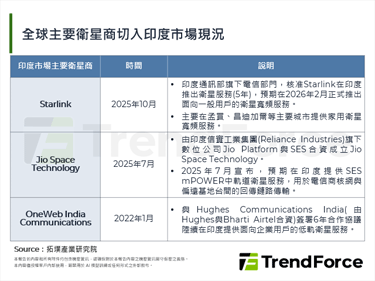Entry-level Smartphone to Steal the Show in 2010 Global Handset Market
In 2009, when global IT industry as a whole seriously tripped over the sweeping financial crisis, handset sector was ablt to fall back on strong demand from emerging markets to see global shipments (white-box not included) fare flat YoY. Chen Wei-hang, analyst with Communications Research Center of Topology Research Institute (TRI), notes that China, India and other emerging nations remain the pillar supportive of global handset shipment growth in 2010, when TRI projects global handset shipments (white-box not included) at 1.329 billion units, up 12% YoY.

Meanwhile, smartphone’s penetration of the handset market should grow from 15% in 2009 to 18% in 2010, when smartphone shipments should amount to 235 million units, hopefully to help stabilize overall handset ASP. Entry-level smartphones that have high gross margin and high growth potential rolled into one should attract brandname vendors in and outside the handset realm to delve into its development, making it the most hyped product in 2010. Taiwan’s output as part of global handset shipments is en route to fall to 4% in 2009 when Motorola and Sony Ericsson both released fewer orders. This will prompt some garden-variety handset manufacturers to shift to design/fabrication of smartphones.
China and India at the core of emerging markets
Chen points out that in 2010, Asia-Pacific (Japan excluded) will grow the fastest among regional handset markets worldwide, as brandname vendors will make inroads into Asia-Pacific with low-end products to seize greater market shares. In China, handset penetration will hit 64% in 2010, when the number of mobile service subscribers will grow to 1.165 billion. As a whole, there are signs that subscriber growth is slowing down in China, but in southeast coastal cities, where 3G replacement will kick off, and in central and western rural China, where penny products will sweep buyers off their feet, we can expect to witness more lively growth. Besides, TRI predicts that in 2010, China’s white-box handset shipments should amount to 260 million units, as Tianyu, Haier, Changhong, Jingli, Hisense, and other white-box handset vendors should have a chance of obtaining certification, transforming into to bona fide brand names, and breaking into local 3G handset market.
Unlike China, where subscriber growth is slowing down, India is still in the thick of high-speed expansion. In 2010, it’s expected that handset penetration will rise to 65.4% in India, where there will be 762 million subscribers. With telecom infrastructure spreading into second- and third-tier cities, India’s mobile phone usage will become more popular among its huge populations.
Lucrative smartphone market up for grabs
TRI’s analysis of 2010 handset products’ ebbs and flows shows that smartphone will grow the fastest, as its global shipments should keep growing to 235 million units, up 29% YoY. Chen points out that smartphone features a higher ASP at US$ 329, which is about three times as much as a feature phone would cost, and nearly ten times a basic phone does. As such, Motorola, HTC, and Palm have all come forward with their own entry-level smartphone, which runs on Open OS and performs and costs somewhere between a feature phone and a traditional high-end smartphone. This combination of decent performance and acceptable price tag will help prod more buying of smartphone to make it the hottest consumer electronic product in 2010.
What’s noteworthy is that optimistic about the prospects of entry-level smartphone, non-handset brandnames like those active in PC, telco, and handheld equipment sectors have all jumped on the bandwagon. Cases in point include Acer, Dell, China Mobile, Vodafone, T-Mobile, Garmin, to name just a few. By joining the smartphone market, they will create more demand for handset OEM/ODM to help Taiwanese handset assemblers rely less on manufacturing of low-priced handsets from which they can only earn pennies, and gradually increase sales exposure to smartphone assembly that yields more. On improved product mix and precise targeting of consumers, Taiwanese handset makers should reap heightened margins and increased orders.
Innovative specifications the key to winning out
Besides, TRI points out that in 2010, handset specifications and applications will proceed in a number of directions. First, wafer-grade packaged camera module technology has matured to the point where over 80% of handsets are built in with cameras. As such, TRI expect smartphones with 5 million-pixel camera modules will fast penetrate the mass market.
In 2010, handset screens will not just get bigger, but will see the application of OLED panel, which boasts of the ability to generate light on its own (thus rendering backlight redundant), saturated colors, high-comparison pictures, quick image reaction, power efficiency, wide viewing angles, light-weight, and slim form-factor. As such, OLED should continue to stir up buzz for mid- to high-end handset market.
Among competing communications systems, GSM family (GSM, GPRS, EDGE, WCDMA, HSPA) remains the mainstream, while global 2G market will continue to grow as it penetrates second- and third-tier cities in emerging nations. GSM, in particular, should turn heads with high growth. Meanwhile, global 3G market should be inspired by recovery of mature markets, upgrade demand from emerging markets, and increased smartphone consumption to maintain growth in 2010, when global handset shipments will continue to grow as a result. WCDMA, among competing 3G protocols, carries highest expectations, while TD-SCDMA will grow relatively faster on lower benchmark.






